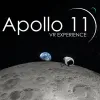Take a look inside 13 images
Apollo 11 VR
Pros: High-quality audio/visuals; cinematic style connects with players on an emotional level; brisk pace will keep students engaged.
Cons: Isn't meant to provide scientific explanations; optional interactive components may frustrate; mobile version has technical issues.
Bottom Line: If infused with good teaching, this cinematic experience can provide a rich, unforgettable adventure.
On its own, Apollo 11 VR provides an impressive, cinematic-style experience. It was designed to connect to players on an emotional level, so don't expect it to stop and explain the physics behind what's going on, provide formulas, or check students for understanding. The emotional connection is so well done that it has massive potential for creating fertile ground for learning.
Apollo 11 VR is neatly broken into stages such as the launch, docking to the lunar module, re-entry into the atmosphere, and several others. Teachers can choose a few of these as the initial portions of a lesson that serves to connect to students by appealing to their curiosity. Teachers can let the VR experience suck the students in, and follow it up with real physics teaching that explains all of the interactions and forces at play. After this, they can repeat the process with new stages.
History teachers can use Apollo 11 VR to strengthen student understanding of the space race and examine excerpts of President Kennedy's powerful speech where he makes a case for a human-crewed mission to the moon. It uses actual recordings, including radio transmissions, which could be used as primary sources in other work. Teachers of younger students studying space will still find the experience a useful anchoring event and can use Apollo 11 VR as a starting point for many valuable discussions -- such as why parachutes are used during re-entry, or why a space suit is needed. Any student that loves space will likely find that Apollo 11 VR will have a substantial impact on them.
Apollo 11 VR is a virtual reality (VR) experience available on the HTC Vive, Oculus Rift, and Google Daydream's mobile VR platform. In many ways, it feels like the player is participating in a documentary about Apollo 11. It begins in what could be a den or living room in the 1960s, with a projection of President Kennedy's famous speech playing. As the player watches, different images are spliced in with the speech, which is accompanied by music that enhances the emotional impact.
The player is then transported above the rocket that will soon be launching, listening to astronauts explain their thoughts and feelings on the morning of launch. Students then spiral down to the base of the structure and ride the elevator with the astronauts. Next, the launch sequence occurs, which the player will experience from inside the control module -- and it feels like getting launched into space, peering out of tiny windows and glancing at the astronauts by your side. This pattern of switching the player from being one of the astronauts to an outside observer is one that Apollo 11 VR regularly repeats to great effect, keeping the experience fresh and moving at a brisk pace. Apollo 11 VR can be finished in around 30 or 40 minutes.
The entire game can be played in "cinematic" mode, where players are going along the well-crafted ride. There's an option to participate in interactive components, such as docking the control module or landing the lunar module. These interactive portions were very challenging to complete -- but then, nobody ever said landing on the moon was easy.
Note that there are three versions of the game available: Apollo 11 VR, Apollo 11 VR HD, and Apollo 11 VR Mobile Experience. All are essentially the same game, with the HD version having updated graphics. By comparison, the mobile version is the least impressive visually, but it still looks good and provides the "I'm an astronaut rocketing into space" feeling. One caveat though: On the devices the mobile game was tested on, the re-entry stage crashed the game every time. It periodically crashed at other times as well.
On its own, Apollo 11 VR is a powerful cinematic experience, light on "in your face" teaching. Students would be engaged, have a lot of fun, and would likely walk away being able to articulate some new knowledge and appreciation for this momentous event. It's up to the teacher to take this experience and provide instructional opportunities that bring deeper understandings and impactful learning. The developers need to fix the crashing on the mobile version, mainly since that's the version that most schools are likely to be using. Teachers will find they can create an impactful and worthwhile teaching and learning experience even with these issues.





















